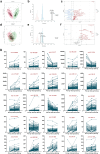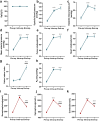Association of exhaled breath volatile organic compounds with surgical traumatic stress
- PMID: 40413404
- PMCID: PMC12103768
- DOI: 10.1186/s12871-025-03140-9
Association of exhaled breath volatile organic compounds with surgical traumatic stress
Abstract
Purpose: This study explored the association of surgical traumatic stress with volatile organic compounds (VOCs) in breath.
Methods: Exhaled breath and blood samples were collected from 105 patients under general anesthesia at three time points: prior to incision (Pre-op), 2 h after incision (Intra-op), and prior to extubation (End-op). Differential mass spectral features between these time points were screened. Traumatic stress-related biomarker detection and mixed-effects model analysis were performed to define correlations and significance between parameters. Subgroup analysis was conducted to test the ability of mass spectral features to distinguish different surgical routes (open vs. laparoscopic).
Results: The abundances of mass spectral features changed significantly between these time points. All stress-related biomarker increased dramatically in the Intra-op group and decreased significantly after operation. Mixed-effects model analysis revealed that several features were significantly correlated with stress biomarkers. Most importantly, subgroup analysis revealed that different surgical routes failed to be distinguished by mass spectral features.
Conclusion: Surgical traumatic stress may change the exhaled breath mass spectral features in perioperative patients, providing preliminary evidence for mass spectral features use in future monitoring of this stress response.
Keywords: Exhaled breath; General anesthesia; Surgical traumatic stress; Volatile organic compounds.
© 2025. The Author(s).
Conflict of interest statement
Declarations. Ethics approval and consent to participate: This study was performed per the principles of the Declaration of Helsinki. Approval was granted by the Ethics Committee of West China Hospital of Sichuan University (Chengdu, China) on June 2, 2022. Informed consent was obtained from all individual participants included in the study. Consent for publication: Not applicable. Competing interests: A Chinese patent based on this study is under review. The authors have no other relevant financial or non-financial interests to disclose.
Figures




Similar articles
-
Volatile organic compounds in exhaled breath are independent of systemic inflammatory syndrome caused by intravenous lipopolysaccharide infusion in humans: results from an experiment in healthy volunteers.J Breath Res. 2017 Apr 11;11(2):026003. doi: 10.1088/1752-7163/aa6545. J Breath Res. 2017. PMID: 28397711 Clinical Trial.
-
Breath carbonyl compounds as biomarkers of lung cancer.Lung Cancer. 2015 Oct;90(1):92-7. doi: 10.1016/j.lungcan.2015.07.005. Epub 2015 Jul 19. Lung Cancer. 2015. PMID: 26233567
-
Standardised exhaled breath collection for the measurement of exhaled volatile organic compounds by proton transfer reaction mass spectrometry.BMC Pulm Med. 2013 Jul 9;13:43. doi: 10.1186/1471-2466-13-43. BMC Pulm Med. 2013. PMID: 23837867 Free PMC article.
-
Inconsistencies in predictive models based on exhaled volatile organic compounds for distinguishing between benign pulmonary nodules and lung cancer: a systematic review.BMC Pulm Med. 2024 Nov 2;24(1):551. doi: 10.1186/s12890-024-03374-2. BMC Pulm Med. 2024. PMID: 39488679 Free PMC article.
-
Breath volatile organic compounds (VOCs) as biomarkers for the diagnosis of pathological conditions: A review.Biomed J. 2023 Aug;46(4):100623. doi: 10.1016/j.bj.2023.100623. Epub 2023 Jun 17. Biomed J. 2023. PMID: 37336362 Free PMC article. Review.
References
MeSH terms
Substances
LinkOut - more resources
Full Text Sources
Medical
Miscellaneous

